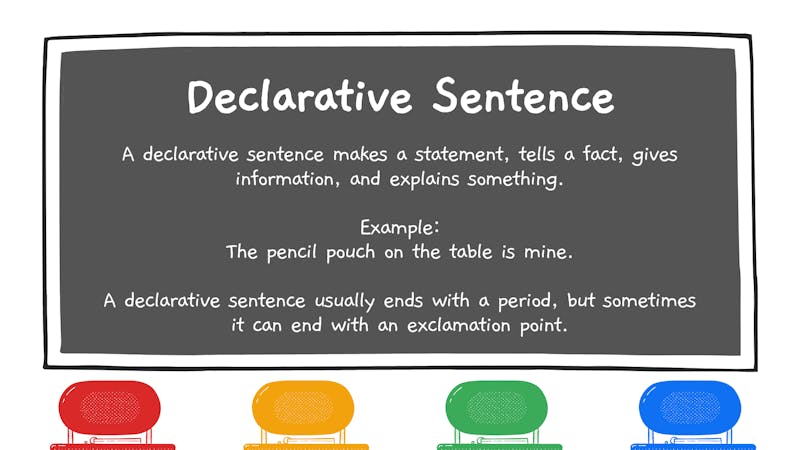What Is a Declarative Sentence?
This list of guidelines should help students at either elementary or middle levels learn about the basics of declarative sentences and their structure. Although we will start with the building blocks of declarative sentences, teachers should be able to use our guide as a nearly complete resource that will provide students with the answers to any questions they might have about declarative sentence examples and their use. Because this type of sentence is quite basic in English, the tips we write here may help ESL learners at these grade levels, too.
The structure and use of declarative sentences in writing or speaking make them the most basic or common type that people will use in English. Students might come across the declarative sentence by another name, the declarative clause. In either case, the sentence will start with a subject and include a predicate. As the name suggests, a sentence in the declarative will state something outright. Once students start learning about the basic structure of this sentence type, they can try to see if the words they read are making a general statement. If they are, the chances are high that they are dealing with declarative sentence examples.
Basic Rules For Declarative Sentences
Before we get into the mechanics of how the English language creates declarative statements, it may be helpful for students to learn what kinds of things do not count as declarative.
There are several things that sentences in the declarative form cannot do. They are not able to
- ask any questions
- issue commands
- express strong emotions about something
For example, the following are not types of declarative sentences.
- Do you have any milk to spare?
- Go and clean the carpet right away.
- I really love sunny days all year round!
Types of Declarative Sentences For The ELA Classroom
If you find that a sentence manages to do any of these things we listed in the first set of bullet points above, the rules dictate that it is not a declarative one. However, this is not the only stipulation that applies to the declarative. These types of sentences will denote a state of being active. Further, they typically do so in the present tense. Although it is not true in every case, they will almost always use a form in which the subject precedes the verb. Because they are making statements, declarative sentences almost always end with periods as punctuation. So, what do declarative sentences look like, and what are the different types?
Simple Declarative Sentence Examples
The previous sections should have helped to cement what declarative sentences are not. For this part of the guide, we will try to provide some basic and clear examples of what these sentences are, and we will focus on how they tend to look within the structure of English language mechanics. We’ll start this by giving a few examples of the main types of declarative sentences students might encounter in writing. For the most part, students may come across two main types of declarations: simple and compound.
A simple declarative sentence will feature only a single clause. They will have a subject and predicate.
Some simple declarative sentence examples are:
- Robert enjoys reading.
- April likes to sing.
- I don't like sweating.
- They enjoy chatting together.
- Geoffrey likes to eat seafood.
- I like running.
- Cats are cute.
- My grandpa is ninety years old.
Think of declarative sentences like statements that relay information back to the reader or speaker.
Flashcard Checkpoint
Check for your understanding of what a declarative sentence is and isn't. Flip the flashcards and reveal the answers.
Compound Declarative Sentence Examples
The compound declarative form has more than one complete phrase in it. The pieces of this sentence can relate to each other in some way, and the mechanics of English use commas and conjunction words in order to connect them. In some cases, you can use a semicolon in order to achieve the same effect.
- Denny wants to go to the shopping center, but Alison does not want to go.
- Rachel needs a new way to care for her hair; she knows that it cannot handle the humidity.
- Harry enjoys running outdoors, but only if it is raining.
- Sally plays the guitar, and Tom sings.
- Our school has new classrooms, but the yard is tiny.
- The sun is shining today, a perfect day for a picnic.
- Tommy is sick; therefore, he isn't coming to school.
Looking for things like commas, conjunctions, or semicolons is a good way to learn how to tell simple and compound declarative sentences apart.
Flashcard Checkpoint
Test your knowledge of simple and compound declarative sentences. Flip the flashcards, and you'll get some more examples.
Conclusion
We make statements in English several times daily. When we do, we turn to the declarative sentence for our needs. However, students will encounter other sentence types as they read, speak, or listen. Some of these might include the same ones we touched on earlier, such as the interrogatory, imperative, or exclamatory. Writers can further break each type into conditional, compound, or complex categories. Check out our related content for more examples and articles to craft a perfect teaching experience for sixth graders, ESL students, or online tutoring.
